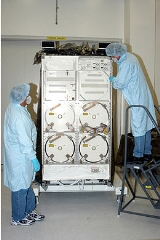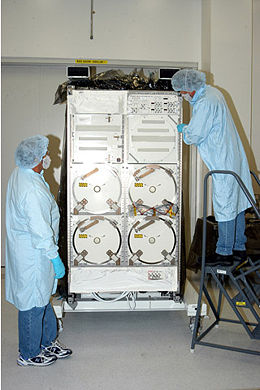
Minus Eighty Degree Laboratory Freezer for ISS
Encyclopedia
The Minus Eighty-Degree Laboratory Freezer for ISS (MELFI) is a European
-built experiment storage freezer for the International Space Station
. It comprises four independent dewars
which can be set to operate at different temperatures. Currently temperatures of −80°C, −26°C, and +4°C are used during on-orbit ISS operations. Both reagent
s and samples will be stored in the freezer. As well as storage the freezer is designed to be used to transport samples to and from the ISS in a temperature controlled environment. The total capacity of the unit is 300 litres.
 The first MELFI unit, FU-1, was flown to the station in 2006 on STS-121
The first MELFI unit, FU-1, was flown to the station in 2006 on STS-121
, installed in the Destiny Laboratory Module
, and commissioned by Thomas Reiter
.
The MELFI flight units were originally designed to be flown fully powered in the Multi-Purpose Logistics Module
,
permitting pre-made experiments to be flown to the station without contaminating or destroying any samples.
The plan was to cycle the three MELFI units between orbit and Earth.
The final MELFI unit was flown to the ISS on board Space Shuttle Discovery
during the STS-131
mission in 2010.
Each dewar is a cylindrical vacuum-insulated 75 litre container and can accommodate samples of a variety of sizes and shapes. The initial delivery of the unit also included a number of spare dewars.
MELFI was developed by the European Space Agency
. Two units have been supplied to NASA and one to the Japan Aerospace Exploration Agency
(JAXA). In addition ground units for training, experiment preparation, and use in control experiments have been built."STS-121 Nasa Press Kit" NASA Press Kit - STS-121, May 2006.
MERLIN (Microgravity Experiment Research Locker/ Incubator, +37°C to -15°C) and
GLACIER (General Laboratory Active Cryogenic ISS Experiment Refrigerator, –80°C to –180°C). As of June 11, 2009, MERLIN was being used aboard the station, "for cold storage of crew food and drink."
Europe
Europe is, by convention, one of the world's seven continents. Comprising the westernmost peninsula of Eurasia, Europe is generally 'divided' from Asia to its east by the watershed divides of the Ural and Caucasus Mountains, the Ural River, the Caspian and Black Seas, and the waterways connecting...
-built experiment storage freezer for the International Space Station
International Space Station
The International Space Station is a habitable, artificial satellite in low Earth orbit. The ISS follows the Salyut, Almaz, Cosmos, Skylab, and Mir space stations, as the 11th space station launched, not including the Genesis I and II prototypes...
. It comprises four independent dewars
Dewar flask
A Dewar flask is a vessel designed to provide very good thermal insulation. For instance, when filled with a hot liquid, the vessel will not allow the heat to easily escape, and the liquid will stay hot for far longer than in a typical container...
which can be set to operate at different temperatures. Currently temperatures of −80°C, −26°C, and +4°C are used during on-orbit ISS operations. Both reagent
Reagent
A reagent is a "substance or compound that is added to a system in order to bring about a chemical reaction, or added to see if a reaction occurs." Although the terms reactant and reagent are often used interchangeably, a reactant is less specifically a "substance that is consumed in the course of...
s and samples will be stored in the freezer. As well as storage the freezer is designed to be used to transport samples to and from the ISS in a temperature controlled environment. The total capacity of the unit is 300 litres.

STS-121
STS-121 was a space shuttle mission to the International Space Station flown by Space Shuttle Discovery. The main purposes of the mission were to test new safety and repair techniques introduced following the Columbia disaster of February 2003 as well as to deliver supplies, equipment and...
, installed in the Destiny Laboratory Module
Destiny Laboratory Module
The Destiny module is the primary operating facility for U.S. research payloads aboard the International Space Station . It was berthed to the Unity module and activated over a period of five days in February, 2001...
, and commissioned by Thomas Reiter
Thomas Reiter
Thomas Arthur Reiter is a retired European astronaut and is a Brigadier General in the Luftwaffe currently working as Director of Human Spaceflight and Operations at the European Space Agency . , he was one of the top 25 astronauts in terms of total time in space...
.
The MELFI flight units were originally designed to be flown fully powered in the Multi-Purpose Logistics Module
Multi-Purpose Logistics Module
A Multi-Purpose Logistics Module is a large pressurized container used on Space Shuttle missions to transfer cargo to and from the International Space Station . An MPLM was carried in the cargo bay of a Shuttle and berthed to the Unity or Harmony modules on the ISS. From there, supplies were...
,
permitting pre-made experiments to be flown to the station without contaminating or destroying any samples.
The plan was to cycle the three MELFI units between orbit and Earth.
The final MELFI unit was flown to the ISS on board Space Shuttle Discovery
Space Shuttle Discovery
Space Shuttle Discovery is one of the retired orbiters of the Space Shuttle program of NASA, the space agency of the United States, and was operational from its maiden flight, STS-41-D on August 30, 1984, until its final landing during STS-133 on March 9, 2011...
during the STS-131
STS-131
STS-131 was a NASA Space Shuttle mission to the International Space Station . launched on 5 April 2010 at 6:22 am from Kennedy Space Center's launch pad 39A, and landed at 9:08 am on 20 April 2010 on runway 33 at the Kennedy Space Center's Shuttle Landing Facility...
mission in 2010.
Each dewar is a cylindrical vacuum-insulated 75 litre container and can accommodate samples of a variety of sizes and shapes. The initial delivery of the unit also included a number of spare dewars.
MELFI was developed by the European Space Agency
European Space Agency
The European Space Agency , established in 1975, is an intergovernmental organisation dedicated to the exploration of space, currently with 18 member states...
. Two units have been supplied to NASA and one to the Japan Aerospace Exploration Agency
Japan Aerospace Exploration Agency
The , or JAXA, is Japan's national aerospace agency. Through the merger of three previously independent organizations, JAXA was formed on October 1, 2003, as an Independent Administrative Institution administered by the Ministry of Education, Culture, Sports, Science and Technology and the...
(JAXA). In addition ground units for training, experiment preparation, and use in control experiments have been built."STS-121 Nasa Press Kit" NASA Press Kit - STS-121, May 2006.
- Weight: 730 kg (1609 pounds)
- Design lifetime: 10 years.
Additional cold storage
During 2007, additional cold stowage and transportation options will become available on the station, includingMERLIN (Microgravity Experiment Research Locker/ Incubator, +37°C to -15°C) and
GLACIER (General Laboratory Active Cryogenic ISS Experiment Refrigerator, –80°C to –180°C). As of June 11, 2009, MERLIN was being used aboard the station, "for cold storage of crew food and drink."
See also
- Scientific research on the ISSScientific research on the ISSScientific Research on the International Space Station is a collection of experiments that require one or more of the unusual conditions present in low Earth orbit. The primary fields of research include human research, space medicine, life sciences, physical sciences, astronomy and meteorology...
- International Standard Payload Rack
- International Space StationInternational Space StationThe International Space Station is a habitable, artificial satellite in low Earth orbit. The ISS follows the Salyut, Almaz, Cosmos, Skylab, and Mir space stations, as the 11th space station launched, not including the Genesis I and II prototypes...
- STS-121STS-121STS-121 was a space shuttle mission to the International Space Station flown by Space Shuttle Discovery. The main purposes of the mission were to test new safety and repair techniques introduced following the Columbia disaster of February 2003 as well as to deliver supplies, equipment and...

